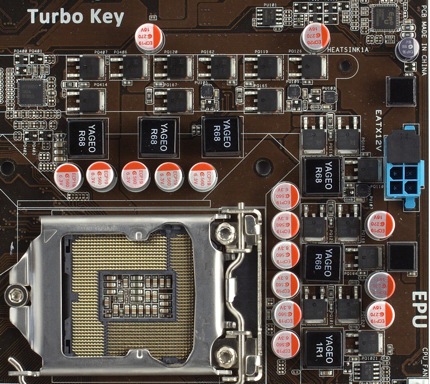Judging by specifications, Intel H55 chipset, the junior solution in the Socket 1156 family, is no conjurer. The lack of support for SLI/CrossFire automatically makes it uninteresting for hardcore gamers. On the other hand, the support for the integrated graphics of Clarkdale CPUs, as well as low price, makes Intel H55 a decent foundation for an inexpensive yet functional microATX machine. Let's see if ASUS P7H55-M Pro still has this advantage.
Design
The layout is spacious enough, typical of larger motherboards. On the other hand, there are not that many parts to cause any layout issues. The set of expansion slots is standard for an inexpensive motherboard: one graphics slot, one PCIe x1 slot, and a couple of PCI slots. Reasonably enough, a dual-slot graphics card will obstruct one of the PCI slots. Unlike Gigabyte and ASRock, ASUS has been installing only one PCIe x16 slot in its H55 motherboards, not trying to exaggerate product features without much reason.

A motherboard of this class will hardly feature advanced power circuitry or cooling system. ASUS P7H55-M Pro uses a relatively simple 4+1+1 phase design with three MOSFETs per lane and the EPU technology. It's interesting that the motherboard has two controllers to power CPU "peripherals" (parts other than the core). One of those, made by Richtek, has two lanes and only uses 50% of its capacity. (This approach is also used in other ASUS motherboards as well.) The CPU socket is surrounded by solid polymer capacitors, while the remaining power circuitry features electrolytic capacitor by Japanese OST/Toshin Kogyo.
The cooling system is quite simple. Besides, it only covers a part of CPU power circuitry. In turn, the chipset is cooled by a miniature heatsink, less than a centimeter high. Owners of large expansion cards will be pleased.
ASUS P7H55-M Pro has just one LED located between the PCI slots. It indicates whether the motherboard is connected to a power source.
The motherboard doesn't boast of ASUS's new proprietary technologies. We have already seen features like BIOS upgrade/recovery from external drives and EPU power controls before. One nice minor feature is that memory sockets have only one latch. But that's nearly a standard these days.
Thanks to ASUS marketing department, the lack of active cooling is proudly named Quiet Thermal Solution. This reduces the price and gives a few more nice words to insert into press releases. Motherboard's cooling system is also supplied by Fan Expert utility you are probably already familiar with.
According to the official website, the motherboard comes bundled with one IDE and two SATA cables. This is quite enough, considering its capabilities. We can't confirm this, because we got an OEM version.
Features
The back panel kind of makes you wonder whether the "Pro" suffix is applicable. ASUS P7H55-M Pro doesn't have USB 3.0, eSATA, Firewire, or Display Port. What it has is six USB 2.0 ports and D-Sub, DVI-D, HDMI video outputs. The lack of Display Port is still more of a rule than an exception. The sound system is also regular: an 8-channel analog output, an optical S/PDIF (Toslink) and HDMI. You can select what digital outputs to use in BIOS. Finally, there's one RJ45 and one PS/2 port.
ASUS P7H55-M Pro is based on the Intel H55 chipset (H55 PCH). Additional features include:
- Integrated audio based on 7.1+2-channel Realtek ALC889 HDA codec. Also present are frontal I/O connectors, optical S/PDIF-Out (Toslink) on the back panel, S/PDIF-Out on the PCB.
- Gigabit Ethernet based on Realtek RTL8112L (PCIe x1) supporting AI Net 2 cable integrity feature.
- IDE based on JMicron JMB368 (PCIe x1) supporting 2 IDE (PATA) drives, including ODD.
Realtek drivers provide no support for additional features like DTS/Dolby. The digital S/PDIF on the PCB supports both 44.1 kHz and 48 kHz sampling rates. We tested the integrated audio solution in the 16-bit/44kHz and 16-bit/48kHz modes using RightMark Audio Analyzer 6.0 and a Terratec DMX 6fire sound card.
| Test |
16-bit/44kHz |
16-bit/48kHz |
| Frequency response (40Hz to 15kHz), dB: |
+0.02, -0.06 |
+0.02, -0.15 |
| Noise level, dB(A) |
-93.1 |
-93.4 |
| Dynamic range, dB(A) |
93.2 |
93.4 |
| THD, % |
0.0011 |
0.0011 |
| THD + noise, dB(A) |
-86.2 |
-86.3 |
| IMD + noise, % |
0.0076 |
0.0068 |
| Channel crosstalk, dB |
-91.8 |
-92.7 |
| IMD at 10 kHz, % |
0.0069 |
0.0064 |
| Total grade |
Excellent |
Excellent |
Conclusions
In our days of multi-part cooling systems, original designs and high-speed interfaces, ASUS still has a few spartan products. ASUS P7H55-M Pro is a decent, unpretentious model. Unfortunately, we can't say it's up-to-date. Nevertheless, if you only need the necessary features the chipset already has, you may put the motherboard to good use.
Taking a look at ASUS's Socket 1156 lineup, you can see that, most likely, the company is focused on adding new SATA 6Gb/s and USB 3.0 functionality to existing P55-based models. As for H55, there are almost no interesting products on that chipset. But that doesn't mean there's nothing to choose from. Inexpensive motherboards have always been the bulk of sales. So, ASUS P7H55-M Pro could've been interesting in terms of price. But, alas, it sells for $99 and more while there are similar products, possibly with a few more controllers, available for less. Perhaps, ASUS is trying to attract users with its brand name and reputation.
The motherboard has been provided by ASUS.
Write a comment below. No registration needed!
